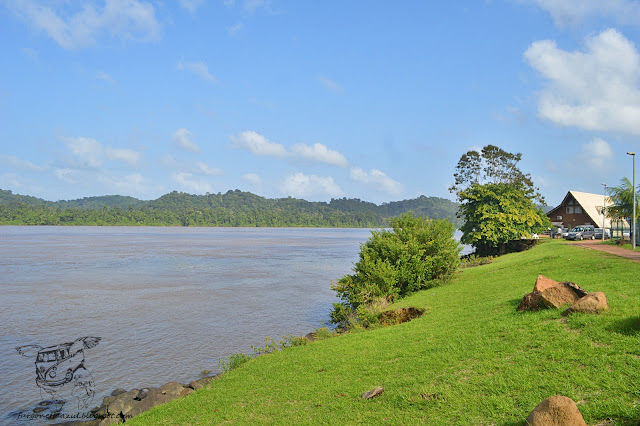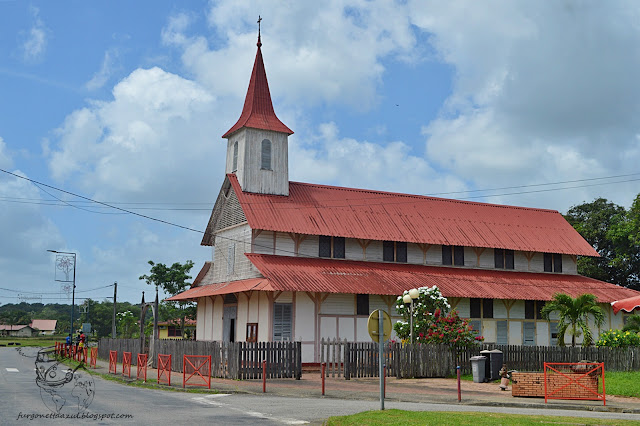 |
| LOS COLORES Y LA BANDERA DE GUAYANA |
Los Carnavales en Guayana Francesa son quizá uno de los acontecimientos mas importantes del año. Estos carnavales, duran semanas e incluso meses y la población local, sobre todo la criolla están totalmente involucrados con sus festividad.
Hay diferentes eventos cada semana, pero sobre todo algo único y típico de Guayana son las noches "Touloulou" donde los festivaleros festejan hasta el amanecer. Son noches donde las mujeres se atavían con disfraces coloridos que las cubren desde la cara a los pies y no pueden ser reconocidas ni por su propio hermano o marido. Al llegar a las salas de carnaval, son las mujeres disfrazadas quien convidan a bailar a los hombres allí presentes bajo el estruendo festivo de las orquestas. Durante semanas, este ritual se repite cada fin de semana.
A parte se celebran a lo largo del país las tradicionales cabalgatas, donde asociaciones,colectivos, agrupaciones o grupos de amigos y amigas pasean por las calles de las ciudades. Lo curioso es que cada semana se realiza en una ciudad diferente, acabando el Carnaval con la gran cabalgata de Cayena/Cayenne (la capital). Sin embargo la mas colorida y potente es la de Kourou.
Nosotros disfrutamos del carnaval a nuestra manera acudiendo a distintos eventos en Kourou y Cayenne. Siempre sonriendo ante el ambiente reinante y bailando y disfrutando hasta altas horas de la noche.
El Carnaval en Guayana, es atípico, pero merece la pena disfrutarlo con todos los sentidos.
KOUROU
 |
| LOS TOULOULOU |
 |
| TOULOULOU |
 |
| En rosado- el alcalde de Kourou/ Kourou city mayor in pink/ na rozowo- prezydent miasta Kourou |
CAYENNE
EN
I guess we are a bit late with this story... but we couldn´t leave this one out! Carnival in Guiana is big and very special. It is celebrated from the very beginning of new year (mostly with weekly parades and some outdoor parties) and end big with huge sunday parades in Cayenne, and the biggest one in Kourou.
The big parades are long and colourful and end with dancing on the streets and fireworks.
People prepare for them long in advance and some of the costume are really breathtaking. The parades include everyone who is willing to participate- the groups sign long before and represent all the different ethnic groups that live in Guiana aswell as enterprizes and variety of organizations...
But the parades are not all!
The last two days before the ash wednesday are dedicated to parties on the streets- on one of the days the genders swipe their clothes and so the men wear skirts, and girls dress up as men. The last day are the red devils- everybody dresses in red and/or black!
And there is another big special thing: the Tououlou and Tololo dances!
They are being organized all over Guiana, but the most traditional, popular and the biggest is at Polinas in the outskirts of Cayenne. The evenings of Touloulou are a tradition zhere all the women going to the ball, are dressed up and completely covered, so it is impossible to recognize the person hiding in the costume. Everytning from head to toes should be unrecognizable!You shouldn´t be able to tell the age or skin tone. The Touloulous (the dressed up women) don´t even arrive at the ball with their husbands- even they shouls not know who their wife is! This way the Touloulous can do whatever they want, they can ask anyone to dance and ask anyone to order them a drink. And the men, who don´t dress up for this evening, should never figure out who they have spent their evening with.
To bqlqnce out the Touloulou, there are also Tololo evenings- where the roles change and the men are unrecognizable!
PL
No tak... trochę późno na pisanie o karnawale, ale tego tematu pominąć nie mogliśmy, bo gujański karnawał jest naprawdę wyjątkowy!
Niektórzy nazywają go najdłuższym karnawałem świata, bo hucznie świętowany jest już od samego początku, czyli Nowego Roku (nie ma mowy o delikatnym rozkręcaniu;)). Co tydzień w niedzielę odbywają się parady a w tygodniu imprezy na świeżym powietrzu (grille i muzyka z otwartego bagażnika... choć zdarza się też i na żywo!).
Najważniejsze parady to ta w Cayenne oraz w Kourou- przy czym ta w Kourou jest największa i gromadzi najciekawsze grupy oraz najbardziej szalone przebrania! W paradach mogą uczestniczyć wszyscy- choć zgłaszać się trzeba grupowo i mieć przygotowany temat. Paradują dzieci, młodzież i starzy, są przedstawiciele wszystkich zamieszkujących Gujanę nacji, większych zakładów pracy oraz prywatnych i rządowych organizacji a nawet grupy znajomych, którzy po prostu chcą wesoło spędzić czas. Przygotowania do parad trwają miesiącami. Paradujący tańczą z rytm bębnów oraz trąbek a przejście całej trasy zajmuje kilka godzin! Parady kończą się wielką imprezą taneczną na ulicach i fajerwerkami!
Ciekawe są też ostatnie dni poprzedzające środę popielcową. W poniedziałek mężczyźni zamieniają się ubraniami z kobietami i w takich strojach opanowują ulice, a wtorek to dzień diablików- wszyscy ubierają się na czerwono i/lub czarno!
Najbardziej wyjątkową tradycją podczas karnawału w Gujanie są jednak wieczory Touloulou i Tololo. odbywają się one w różnych miejscach, ale te najbardziej znane są na obrzeżach Cayenne w lokalu Polina, otwartym wyłącznie na tę okazję! A cóż specjalnego jest w tych balach? Otóż obowiązuje na nich specjalny dress codę. Podczas wieczorów Touloulou przebierają się wyłącznie kobiety. Jednak ważne żeby ich przebranie było kompletne- muszą one być nierozpoznawalne. Przebranie musi zakrywać każdy centymetr ciała, nie dając wskazówek co do wieku ani koloru skóry. Nawet jeśli kobieta pojawia się na tym samym balu co jej mąż, przebiera się poza domem, tak aby małżonek nie był w stanie jej rozpoznać!A po co tyle zachodu?Panie Touloulou mają wyłączne prawo proszenia panów do tańca oraz zamawiania na ich koszt napojów. Ponieważ panowie nie są przebrani, panie mogą flirtować bezkarnie z kim chcą- szefem, mężem sąsiadki a nawet płatać figle największym wrogom.
Dla równowagi istanieja oczywiście wieczory, kiedy role się odwracają. Panowie, czyli Tololo, są w przebraniu, a paniom pozostaje zgadywanie!





















































